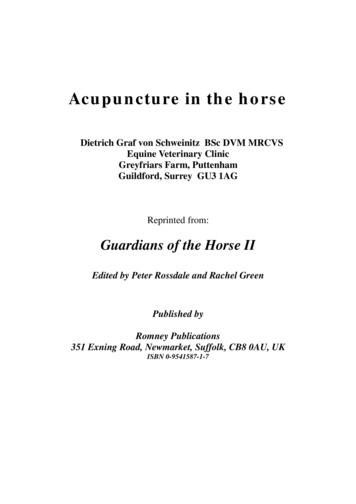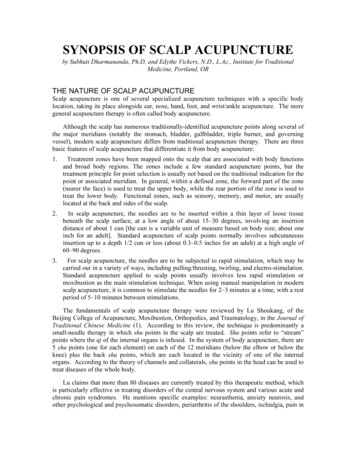
Transcription
SYNOPSIS OF SCALP ACUPUNCTUREby Subhuti Dharmananda, Ph.D. and Edythe Vickers, N.D., L.Ac., Institute for TraditionalMedicine, Portland, ORTHE NATURE OF SCALP ACUPUNCTUREScalp acupuncture is one of several specialized acupuncture techniques with a specific bodylocation, taking its place alongside ear, nose, hand, foot, and wrist/ankle acupuncture. The moregeneral acupuncture therapy is often called body acupuncture.Although the scalp has numerous traditionally-identified acupuncture points along several ofthe major meridians (notably the stomach, bladder, gallbladder, triple burner, and governingvessel), modern scalp acupuncture differs from traditional acupuncture therapy. There are threebasic features of scalp acupuncture that differentiate it from body acupuncture:1.Treatment zones have been mapped onto the scalp that are associated with body functionsand broad body regions. The zones include a few standard acupuncture points, but thetreatment principle for point selection is usually not based on the traditional indication for thepoint or associated meridian. In general, within a defined zone, the forward part of the zone(nearer the face) is used to treat the upper body, while the rear portion of the zone is used totreat the lower body. Functional zones, such as sensory, memory, and motor, are usuallylocated at the back and sides of the scalp.2.In scalp acupuncture, the needles are to be inserted within a thin layer of loose tissuebeneath the scalp surface, at a low angle of about 15–30 degrees, involving an insertiondistance of about 1 cun [the cun is a variable unit of measure based on body size; about oneinch for an adult]. Standard acupuncture of scalp points normally involves subcutaneousinsertion up to a depth 1/2 cun or less (about 0.3–0.5 inches for an adult) at a high angle of60–90 degrees.3.For scalp acupuncture, the needles are to be subjected to rapid stimulation, which may becarried out in a variety of ways, including pulling/thrusting, twirling, and electro-stimulation.Standard acupuncture applied to scalp points usually involves less rapid stimulation ormoxibustion as the main stimulation technique. When using manual manipulation in modernscalp acupuncture, it is common to stimulate the needles for 2–3 minutes at a time, with a restperiod of 5–10 minutes between stimulations.The fundamentals of scalp acupuncture therapy were reviewed by Lu Shoukang, of theBeijing College of Acupuncture, Moxibustion, Orthopedics, and Traumatology, in the Journal ofTraditional Chinese Medicine (1). According to this review, the technique is predominantly asmall-needle therapy in which shu points in the scalp are treated. Shu points refer to “stream”points where the qi of the internal organs is infused. In the system of body acupuncture, there are5 shu points (one for each element) on each of the 12 meridians (below the elbow or below theknee) plus the back shu points, which are each located in the vicinity of one of the internalorgans. According to the theory of channels and collaterals, shu points in the head can be used totreat diseases of the whole body.Lu claims that more than 80 diseases are currently treated by this therapeutic method, whichis particularly effective in treating disorders of the central nervous system and various acute andchronic pain syndromes. He mentions specific examples: neurasthenia, anxiety neurosis, andother psychological and psychosomatic disorders, periarthritis of the shoulders, ischialgia, pain in
the back and loin, painful heels, and other pain syndromes, hemiplegia, aphasia, senile dementia,and other brain disorders.During the 1970’s, scalp acupuncture was developed as a complete acupuncture system.Three major contributors to the development of this system, Jiao Shunfa, Fang Yunpeng, andTang Songyan, each proposed different diagrams and groupings of scalp acupuncture points. Forexample, Jiao divided the scalp points into motor and sensory areas, Fang into writing (speech)and reading (memory) centers, and Tang into upper, middle, and lower burner areas. Severaldifferent methods of needling were proposed. Jiao advocated rapid twirling with penetrating andtransverse needling; Fang favored the slight twirling method and oblique needling; while Tangrecommended long-duration needle retention with superficial stimulation of the needles, using thelifting and thrusting method.Thus, scalp acupuncture is not really a single system, but a multiplicity of systems still indevelopment, with a 30-year history of practical experience. A standard of nomenclature foracupuncture points has been developed (adopted in 1984 and reconfirmed in 1989), indicating 14therapeutic lines or zones based on a combination of the thoughts of the different schools of scalpacupuncture. However, it is often necessary to carefully review the zones relied upon by anindividual practitioner, as few have adopted the unified pattern.As Lu states in his article, Professor Zhu Mingqing (who had been associate professor at Lu’sdepartment in Beijing before emigrating to the U.S.) has developed a popular version of scalpacupuncture. “In recent years, Zhu’s scalp acupuncture has been a craze in Japan, America, andChina. As a school of scalp acupuncture therapy, Zhu’s method is actually derived from thestandard scheme [adopted in China] and based on the clinical experience of Zhu Mingqing. InZhu’s scalp acupuncture, 8 therapeutic zones are used [actually, 9 zones], and the manipulation ischaracterized by forceful, small-amplitude lifting and thrusting of the needle, associated withmassage [of the body part to be affected] and physical and breathing exercises. In fact, thetherapeutic zones in Zhu’s scalp acupuncture are determined on the basis of the standardscheme.”Dr. Zhu has been working as an acupuncturist since graduating from the College of ChineseMedicine in Shanghai in 1964. He served as assistant director of the Scalp Points ResearchGroup of the Chinese Acupuncture Association from 1987 to 1989. Since coming to the U.S., hehas worked closely with Dr. Eva Munwu Chau, former president of the California AcupunctureAssociation. In 1991, Zhu established the Chinese Scalp Acupuncture Center of the U.S.A. inSan Francisco, and, in 1992, he published an English-language book on his methods: Zhu’sScalp Acupuncture (2), now out of print. He currently provides treatments for severalneurological disorders at Zhu's Acupuncture Medical & Neurology Center, in San Jose,California (see Appendix 2 for more on Zhu’s experiences in the U.S.).Dr. Zhu traces the origins of modern scalp acupuncture to the work of Huang Xuelong, whoin 1935 introduced the concept that there is a relationship between the scalp and the cerebralcortex. Several acupuncturists pursued this line, seeking points and zones on the scalp that wouldtreat diseases of the brain. Initial results of clinical work indicated that acupuncture applied to thescalp had good effect on diseases that were associated with cerebral damage, such as stroke. Itsapplications were then extended to virtually all other diseases, but a focus on nervous systemdisorders is still dominant. Other physicians in China trace the acceptance of scalp acupunctureas a new system to the development of ear acupuncture, which is also thought to be especiallyuseful for neurological disorders due to the location of needling at the head.
ZHU’S SCALP ACUPUNCTUREAccording to Dr. Zhu, Baihui (GV-20) is the basis for all of the scalp points. Quoting from theLing Shu: “The brain is the sea of marrow. Its upper part lies beneath the scalp, at the vertex, atpoint Baihui.” The point’s Chinese name indicates that it is the great meeting place (literally:hundred meetings). Traditionally, this point is treated to stabilize the ascending yang; it is alsoneedled in order to clear the senses and calm the spirit.The Governing Vessel enters the brain at point Fengfu (GV-16). The external pathway of theGoverning Vessel is used to divide the left and right sides of the scalp. The left side governs qiand the right side governs blood. Needling of the left side has a greater impact on disorders of theleft side of the head and neck, but of the right side of the body below the neck, and conversely.In Zhu’s system of acupuncture, there are three main zones (designated the Eding zone,Dingzhen zone and Dingnie zone) subdivided into a total of 11 portions, and three secondary zones,each divided into two portions (designated Epang 1, Epang 2, front zone of Dingjie, back zone ofDingjie, Niehou and Nieqian). The zone names are simply based on anatomical descriptions.Following is a review of the primary scalp acupuncture zones (See Appendix 1 for a picture of thezones).Eding ZoneDing refers to the top of the head, and E (pronounced “uh”) refers to the forehead. The Edingzone runs from the forehead to the top of the head. This is a zone that runs along the governingchannel, covering a narrow band from a point 1/2 cun in front of GV-24 (at the forehead/scalpborder) back to GV-20. The width is 1 cun and the length is 5 cun. The Eding zone governs theyin side (front) of the body, running from the perineum (GV-20 area of needling) to the head(GV-24 area of needling). The zone is divided into four regions.Eding 1 is the anterior quarter of the region, extending from GV-24 forward by 1/2 cun. Thisregion is used to treat the whole head and neck region. The effects of treatment in this regioninclude calming the spirit, opening the orifices, arousing the mind, and brightening the eyes. Totreat, insert the needle along the side of the zone that corresponds with the side of the head orneck that is affected. That is, although treatment usually includes one needle in the center of thezone (along the GV line), if the problem is on the right side of the head or throat, place the needleon the right side of the zone. For example, treating blurred vision in the right eye, place oneneedle in the right side of the Eding 1 zone or insert the needle at the center of the zone and directit to the right side of the zone. The direction of needling is usually towards the face.Eding 2 is the second quarter of the zone, extending from GV-24 to GV-22. This region isprimarily used to treat disorders of the chest region. The functions include opening the chest andregulating qi, opening the lungs, stopping wheezing, and calming the spirit. If the problem is onone side of the body, needle the side of the zone on the opposite side (contralateral).Eding 3 is the third quarter of the zone, extending from GV-22 to GV-21. This region is primarilyused to treat disorders of the middle burner (including treatment of acute appendicitis). The functionsinclude stopping vomiting and diarrhea, regulating the liver qi, and regulating the gallbladder. Totreat, use the contralateral side.Eding 4 is the last quarter of the zone, extending from GV-21 to GV-20. This region is used to treatthe lower burner and the lower limbs. The functions include regulating the menses, strengthening thekidneys and promoting urination. Needle on the contralateral side; if the disorder is central, as inbladder dysfunction, needle the central line of the zone or both sides. The direction of needling isusually towards the back of the head.
As described above, Zhu follows the principal that if the disorder affects the left or right sideof the body, then treatment that is intended to affect the head or neck is done on the same side ofthe zone as the side of the disorder (ipsilateral), but if it is below the neck, then the needle isplaced on the opposite side of the zone. This approach has been followed by many scalpacupuncture specialists in China. However, a few researchers claim that clinical evidence doesnot support the need to treat one side or the other; rather, one can alternate sides on subsequentdays. At this time, there is probably insufficient data to demonstrate that one or the otherapproach is significantly better. Alternate side needling might be better tolerated by the patientwhen daily needling is used. For those following Zhu’s technique, treating one side according tolocation of symptoms would be consistent with his extensive clinical experience.Dingzhen ZoneZhen (pronounced “jun”) refers to pillow, and indicates the back of the head. The Dingzhen zoneruns from the top of the head to the back of the head, between GV-20 and GV-17. The zone is 1cun wide. It governs the spine, the yang aspect of the body (back). It can be divided into 4regions, equally spaced from each other. This region is mainly used for pain.Dingzhen 1 (starting at GV-20) governs the back of the head and the neck.Dingzhen 2 governs the vertebrae C-7 (seventh cervical, base of the neck) through T-10 (10ththoracic).Dingzhen 3 governs the vertebrae T-10 through L-5 (fifth lumbar).Dingzhen 4 (ending at GV-17) governs the sacrum and coccyx. Needling here is painful, so it israrely used.The Eding and Dingzhen zones together form a central line from the front to the back of thescalp. In mapping the zones to the body structure, this line represents a continuum from head toabdominal base repeated twice, first covering the front of the body (the more frontal points) andthen the back of the body. The meeting point of the two zones, GV-20, can be used to treat theentire body, depending on the aim of the needle.Dingnie ZoneNie (pronounced “nyeh”) refers to the temple. The Dingnie zone runs from the center top of thehead to the temple, at an angle (aiming to the cheekbones). It is located on a line from GV-21 to1/2 cun anterior to ST-8. The zone is 1 cun wide. It can be divided into 3 equal parts, and eachpart is used as a representation of a body region that can be treated within the zone.Dingnie 1 governs the lower limbs. The homunculus for this zone looks like a person is kneelingwith their foot and thigh on top of each other (near GV-21), and their knees pointing towards ST8. This zone does not include the hip joint.Dingnie 2 governs the upper limbs. The homunculus for this zone like a person with their elbowsbent. The elbow zone is near the region between Dingnie 1 and 2. The upper arm (not includingthe shoulder) and wrist are mapped near the intersection between Dingnie 2 and 3.Dingnie 3 (near ST-8) governs the head. It covers motor-sensory problems. This zone is rarelyused as it can be painful to needle; Eding 1 is usually used instead.Mapping from the frontal hairline back, the top of the body is forward. Also, the sensoryzone is toward the forward part of the Dingnie zone, while the motor zone is toward the back ofthe Dingnie zone. Needling of this zone may include insertion from GV-21 towards ST-8 or inthe reverse direction.
Epang ZonePang (pronounced “pong”) means along the side. The Epang zone is a series of short segmentsalong the border of the forehead/scalp on either side of the central line. This zone is actuallycomprised of short and narrow segments running from the top of the forehead into the hair zone.Epang 1 is used to treat acute diseases of the middle burner. It is located 1/2 cun on either side ofGB-15. The zone is 1/2 cun wide.Epang 2 is used to treat acute diseases of the lower burner. It is located halfway between GB-13and ST-8. The zone is 1 cun long and 1/2 cun wide.This mapping of the body runs from the center line (GV, the Eding zone governing head andthroat) to the side, progressing from head to middle warmer to lower warmer.Dingjie ZoneJie (pronounced “jeah”) refers to being closely bound to something: this is a zone adjacent to GV20. Dingjie has a front zone—Dingjieqian—and a back zone—Dingjiehou. Qian (pronounced“chian”) means forward, and hou (pronounced “how”) means back. The Dingjie zone is a set offour short segments arrayed from the top of the head to the front and back sides of the head.These are short lines radiating forward and back to the sides from GV-20, the meeting spotbetween the end of the Eding zone (corresponding to the genital area) and the beginning of theDingzhen zone (corresponding to the head and neck). The front Dingjie zone treats an area of thebody just above that treated by the end of the Eding zone, and the back Dingjie zone treats an areajust below that treated by the beginning of the Dingzhen zone.Front Zone of Dingjie: This zone is located on a line from GV-20 to BL-7. This area is used totreat the hips and inguinal area.Back Zone of Dingjie: This zone is located on a line from GV-20 to BL-8. It is used to treat thearea above the scapula, the upper trapezius region.Nieqian and Niehou ZonesNie (pronounced “nyeah”) refers to the temple. The Nieqian (meaning forward temple) zone isnear the temple, above and to the front of the sideburn, while the Niehou (meaning back temple)zone is set back from the temple (over the top of the ear). The zones at the sides of the head arerarely used because the needling tends to be painful.Nieqian Zone: This zone is located on a line from GB-4 to GB-6. It is used to treat shaoyangdisorders (those that are deemed half-inside and half-external in nature, and those affecting theliver/gallbladder areas, such as hypochondrium and sides of the chest), side-of-the-face problems,menstrual-related migraines.Niehou Zone: This zone is located on a line from GB-9 to TB-20. It is mainly used to treat diseasesof the ear.MAPPING OF THE BODY WITHIN THE ZONESThe Dingnie zones, which extend at angles towards the front of the head (from GV-21 to ST-8 oneither side) from the central Eding zone, overlap the central zone. The mapping of body parts tothe zones places the foot at the beginning of the Dingnie zone (at GV-21) and the head at the endof the Dingnie zone (at ST-8): Dingnie zone #1 is used for treating the legs; Dingnie zone #2 isused for treating the arms; Dingnie zone #3 is used for treating the head. However, becauseDingnie zone #3 is more painful to needle and, because treatment of the head is adequatelyaccomplished in the Eding zone #1; Dingnie #3 is seldom used by Dr. Zhu.
To visualize the mapping, imagine a person squatting down with arms bent, placing theelbow on the knee, with the hand by the shoulder. The beginning of Dingnie #1 is at the base ofthe foot, this overlaps with the upper thigh due to the squatting position, and then it maps upwardto the knee; the zone then continues up the arm from the elbow towards the hand and shoulder,including the forearm in that same space (Dingnie #2); finally, it follows up the head (Dingnie#3). The foot location of the Dingnie zone #1 extends all the way to the far side of the Edingzone (the Eding zone runs along the governor vessel; the zone covers 1/2 cun on either side ofGV; when needling Dingnie to treat the foot, the point of the needle, threaded into the scalp, restsat the junction of the beginning of Dingnie zone #1, where it meets the far side of Eding.Therefore, the needle enters the scalp behind the Dingnie zone. Dingnie zone #1 does not includethe hips, and Dingnie zone #2 does not include the shoulder girdle; to treat those parts of thebody, Dr. Zhu relies primarily on the Dingnie zones. Aside from the standard zones, palpation ofthe scalp for tender points helps Zhu to identify the specific needling sites within the selectedzone. The Eding zone is the most frequently used of the scalp zones, with the Dingnie zonesbeing used additionally for treating affected limbs.When treating a neurological problem that affects the extremities, the needles are directed,along a zone, towards the opposite extremity. Thus, for example, if the left leg is affected, theneedle will be directed outward along Dingnie #1 on the right side of the scalp. Only forproblems of the head and neck is the needling done on the same side of the scalp as the disorder.For disorders that are not specific to a body location, such as hypertension or epilepsy, needlingmay be done on both sides of the zone.If the disorder to be treated is associated with a degenerative disease involving a kidneydeficiency syndrome (common in elderly patients and those with chronic, degenerative diseases),then Eding zone #4 is usually needled. A typical needling pattern is: one needle in the center ofthe zone, and one needle on either edge of the zone, about 0.5 cun apart from the central needle;for a total of 3 parallel needles in the zone, with the central needle leading the other 2 by about0.5 cun, producing an arrow formation; the outer 2 needles are directed towards the part of thezone that corresponds to the kidney, while the inner needle is directed toward the part of the zonecorresponding to the genitals.Dr. Zhu sometimes uses a “crossing” technique for needle positioning, mainly in treatingcases of severe pain. He selects a zone site for treatment, and inserts one needle along the zoneand then inserts a second needle perpendicular to that one, going across the zone and crossingover the first needle. As an example for right-knee pain, a needle is first directed along Dingnie#1 towards the left temple, and then a second needle is inserted across that one. The secondneedle is stimulated by the draining method. In cases of quadriplegia, another crossing techniqueis used. The first needle is inserted across the zone (e.g., from the left part of the zone to the rightpart of the zone, at about a 45 degree angle), and then a second needle, crossing over the first(e.g., from the right part of the zone to the left part of the zone). In some cases, a series of crossover needles are inserted along the length of a zone (this may incorporate as many as 3 pairs ofneedles).THE NEEDLING TECHNIQUEThe needle size often mentioned in Chinese texts for scalp acupuncture is 26, 28, or 30 gauge,which is suitable for rapid twirling techniques. For Zhu’s needle stimulation technique (thrustand pull method), a somewhat finer needle gauge of 32 or 34 is suitable for most cases, and theinsertion length is approximately 1 cun. A 30 mm (1.2 inch) needle with a wound head is thoughtto be the best. The needle must be long enough so that it is not inserted up to the handle, butshort enough that there will not be any bending during insertion and manipulation. The angle of
insertion is typically 15–25 degrees. The patient should not feel pain, though there are somerarely used scalp points along the sides of the head, mentioned above, that typically produce pain.The needle is inserted along the practitioner’s nail pressing the skin. Press besides thetreatment zones with the nail of the thumb and first finger of the left hand, hold the needle withthe right hand, and keep the needle tip closely against the nail. By avoiding the hair follicle, onecan minimize pain during insertion. The direction of needling is usually based on the mapping ofthe body within the zone being treated: the needle is aimed (along the line of the zone) towardthat portion of the zone most closely corresponding to the area of the body that is affected by theinjury or disease.Although the distance from the skin surface to the skull is very short, there are several tissuelayers: the skin, hypodermis, galea aponeurotica and occipito-frontalis muscles, subaproneuroticspace, and pericranium. The subaproneurotic space is a loose layer of connective tissue that isideal for penetration during scalp needling: the needle slides in smoothly and does not cause pain,yet the desired needling sensation is strong. If the angle of needling is too shallow, the needlewill penetrate the skin and muscle layers and it will be difficult to get a smooth insertion.Upon inserting the needles, stimulation is applied for 1–2 minutes (see below for stimulationtechnique). The needles are manipulated again after intervals of 10–15 minutes, for 1–2 minuteseach time, throughout the duration of the patient visit, which may be as long as 2–3 hours.Sometimes, the interval between needle stimulation sessions is longer due to insufficient stafftime when there are numerous patients, but usually within 30 minutes.The needles should remain in the scalp for a minimum of 4 hours (except for treatment ofacute symptoms, in which case, 0.5–1 hour is sufficient) and up to a maximum of 2 days.However, for children and weak adults, the time of retention should be shorter. Dr. Zhu generallyprefers long-term needle retention of 1–2 days; this is in contrast to the method of Jiao Shunfa,who advocated removing the needles after the basic manipulations. At Zhu’s clinic, the scalpneedles are often left in place when the patient leaves, and are not removed until the next visit,which is 24–48 hours later. At that time, new needles are inserted at different points. If severalparts of the body are affected by the illness or injury, the points selected may be rotated through acycle aimed at treating each of the different body parts.There are two basic needling methods for manipulating the qi, designated jinqi and chouqi,that have been elucidated by Dr. Zhu. Both are based on ancient techniques and involve a rapid,short distance movements. Jinqi (jin means move forward) is a tonifying, thrusting method.“Thrust the needle quickly with violent force, but the body of the needle doesn’t move, or nomore than 0.1 cun in.” Following the thrust, the needle is allowed to settle back to its originalposition. Chouqi (chou means to withdraw) is a sedating, reducing method. It is based onforceful movement and a lifting motion. “Lift the needle quickly with violent force, but the bodyof the needle doesn’t move, or no more than 0.1 cun out.” Again, after the pull, the needle settlesback to its original position.Lu Shoukang mentions in his article that he prefers using the small-amplitude, forceful liftingmethod, rather than the twirling method, because “it saves the operator effort and gives thepatient less suffering.” He describes his preferred method as follows: “When inserted to a certaindepth (about 1 cun), the needle is forcefully lifted outwards or thrust inwards. The direction[angle] of lifting or thrusting is the same as that of the insertion. The outward and inward forceexerted on the needle should be sudden and violent as if it is the strength from the whole body ofthe operator. The lifting and thrusting amplitude should be small, no more than 1 fen [1/10 cun].After lifting and thrusting continuously for three times, the needle body is sent back to the
original place (about one cun) and significant therapeutic effects will be obtained after themaneuver is repeated for 2–3 minutes.”For the majority of neurological disorders, the tonification technique (jinqi) is used, with aseries of rapid, very small-amplitude, in-out needle movements. The emphasis is on the forwardmovement, then allow the needle to naturally pull back to the starting position. In cases of painsyndromes, the draining method (chouqi) is used, with the same kind of rapid, limited distancemovements, but with the emphasis on outward movement, then allowing the needle to settle back into the starting position. During the stimulations, it is important for both the practitioner and thepatient to focus on the breath (this is an aspect of qigong therapy that is incorporated into thetreatment). There should be no talking during needle stimulus: all attention is on the needling andits effects. The mental focus is on “directing the breath” to the body part that is to be affected.Regarding repetitions of the stimulus, Zhu says: “Repeat many times until revival of qi andeffect is achieved.” He usually does not specify a manipulation duration, but rather bases theduration on observed response. He claims that by using the small amplitude manipulationmethod rather than the twirling method, one has the advantages of “large amount of stimulation,saving effort, less pain sensation, and strong needling sensation,” yet the therapeutic effects areachieved quickly. The method is also easy to master, though success may depend on the qi of thepractitioner when utilizing the forceful but small amplitude manipulations. Dr. Zhu does not relyon moxa, due to the problems associated with large amounts of smoke in the group treatmentsetting and lack of adequate ventilation at the Neurology Center. He does use heat lamps toprovide heat to an affected body part, when it is deemed valuable.The affected part of the body is to be moved during needle stimulation. If the person cannotmake the movement on their own, then the patient will visualize moving the breath to the affectedpart and, when possible, an assistant will move the body part. After the needle stimulation, thepatient is encouraged to continue the movements. In cases where the legs are involved, thepatient walks, if possible (several patients at Zhu’s clinic would walk around the block, othersmight walk the length of the room). Dr. Zhu expressed the belief that a function of scalpacupuncture is to improve or re-establish the connections from the central nervous system to theperipheral nervous system. The sending of signals between these two parts of the nervous systemduring treatment is critical. The intention of the patient to move the affected body part (or themental practice of moving the breath to the body part) sends signals from the central nervoussystem to the periphery, while actual movements of the body part send signals back from theperiphery back to the central system.Before withdrawing the needles, Zhu recommends manipulating the needle again while thepatient performs breathing exercises. When it is time to remove the needles, press the skinaround the point with the thumb and index finger of the left hand, rotate the needle gently and liftslowly to the subcutaneous level. From there, the withdrawal should be rapid, and the puncturedsite should be pressed for a while with a dry cotton ball to avoid bleeding.Body points are sometimes used as an adjunct to the scalp acupuncture therapy. Dr. Zhu usesrelatively few body points (typically 1–3, if any), but emphasizes obtaining the qi sensation withpropagation of qi sensation towards the affected part. Examples of
THE NATURE OF SCALP ACUPUNCTURE Scalp acupuncture is one of several specialized acupuncture techniques with a specific body location, taking its place alongside ear, nose, hand, foot, and wrist/ankle acupuncture. The more general acupuncture therapy is often called body acupuncture. Although the scalp has numerous traditionally-identified .

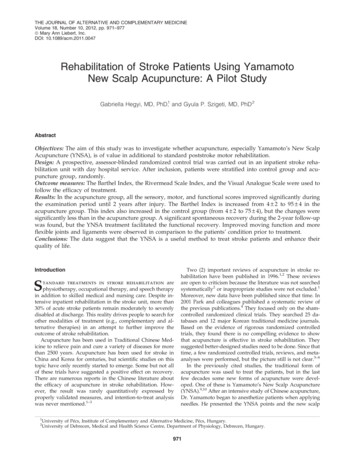
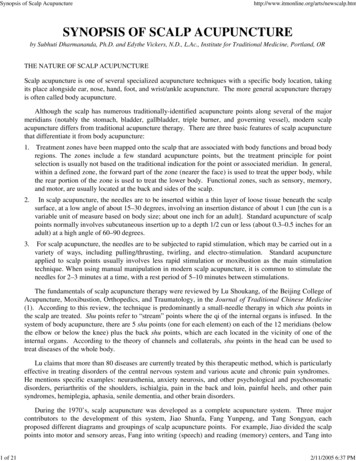

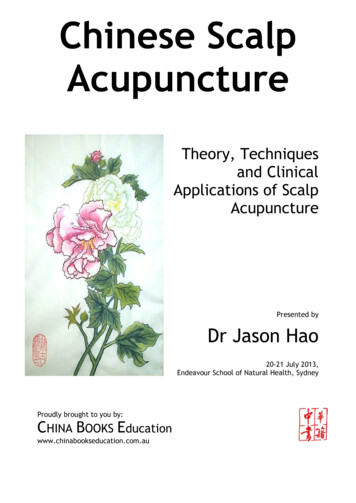
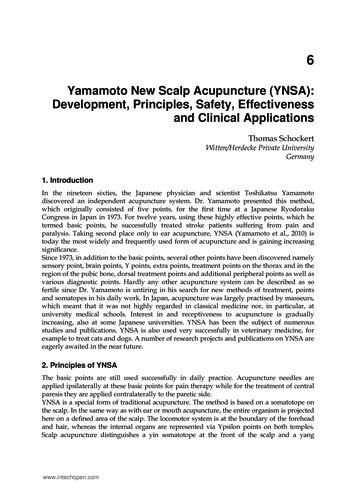
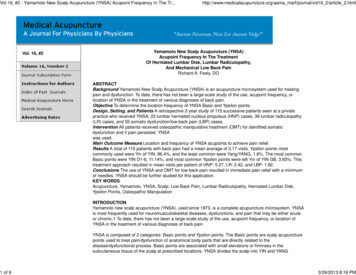
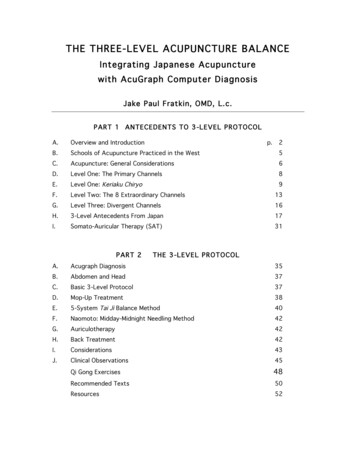
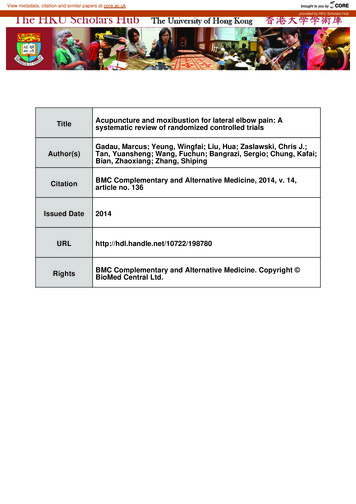
![[T] Effects of Ai Chi and Yamamoto new scalp acupuncture on chronic low .](/img/60/camilotti-bm-et-al-2015-low-back-pain-and-ai-chi-2.jpg)
